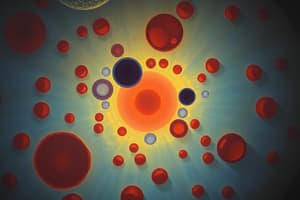Podcast
Questions and Answers
What is the function of the nucleolus?
What is the function of the nucleolus?
- Synthesizes lipids for the cell membrane
- Breaks down cellular waste
- Packages proteins for exocytosis
- Synthesizes components of ribosomes (correct)
What is the function of the Golgi apparatus?
What is the function of the Golgi apparatus?
- Synthesizes proteins for the cell membrane
- Modifies proteins and acts as a cellular post office (correct)
- Breaks down cellular waste
- Produces most of the ATP for the cell
What is the role of the electron-transport system in mitochondria?
What is the role of the electron-transport system in mitochondria?
- Converts proteins into glycoproteins
- Breaks down cellular waste
- Packages proteins for exocytosis
- Produces most of the ATP for the cell (correct)
Flashcards are hidden until you start studying
Study Notes
- The nucleus occupies about 10% of the cell's volume and has a double membrane called the nuclear envelope with nuclear pores.
- The nucleolus is an organelle within the nucleus that synthesizes components of ribosomes.
- Chromatin consists of DNA molecules bound with histone proteins and condenses into chromosomes before cell division.
- Mitochondria are sites of most aerobic respiration reactions and have two membranes, with the inner membrane folded into cristae for increased surface area.
- The Golgi apparatus consists of flattened membrane-bound sacs that modify proteins, including adding tags that determine their final destination.
- The Golgi apparatus acts as a cellular post office that distributes molecules.
- Modified molecules are released from the Golgi apparatus in vesicles to be carried to other parts of the cell or to the plasma membrane for exocytosis.
- Vesicles can also form lysosomes.
- The electron-transport system in the inner membrane of mitochondria produces most of the ATP.
- The Golgi apparatus converts proteins into glycoproteins.
Studying That Suits You
Use AI to generate personalized quizzes and flashcards to suit your learning preferences.




